Fri, Jul 03, 2009
Plane Struck Belly-First At Very High Speed
 The French agency
investigating the Air France 447, which crashed in the Atlantic
Ocean June 1st, says the aircraft impacted the water intact, belly
first, at a very high rate of speed, the World Associated Press
reported Thursday.
The French agency
investigating the Air France 447, which crashed in the Atlantic
Ocean June 1st, says the aircraft impacted the water intact, belly
first, at a very high rate of speed, the World Associated Press
reported Thursday.
Alain Bouillard who is leading the probe for the French accident
agency BEA said that one month after the crash, "we are very far
from establishing the causes of the accident."
While the pitot tubes on the A330 that have been the focus of
intense speculation in this incident, and others under
investigation by the NTSB, they were not cited as the cause of the
disaster. "It is an element but not the cause," Bouillard told a
news conference in Le Bourget outside Paris. "The investigation is
a big puzzle," he continued. "Today we only have a few pieces of
the puzzle which prevents us from even distinguishing the photo of
the puzzle."
 The heavy storms and
lightning in the area of AF447 were also downplayed in Bouillard's
presentation. Meteorological data show the presence of storm clouds
in the area the jet would have flown through, but nothing out of
the ordinary for the equatorial region in June, Bouillard said,
eliminating the theory that the plane could have encountered a
storm of unprecedented power. Other flights through the area
shortly after Flight 447 disappeared didn't report unusual weather,
Bouillard said.
The heavy storms and
lightning in the area of AF447 were also downplayed in Bouillard's
presentation. Meteorological data show the presence of storm clouds
in the area the jet would have flown through, but nothing out of
the ordinary for the equatorial region in June, Bouillard said,
eliminating the theory that the plane could have encountered a
storm of unprecedented power. Other flights through the area
shortly after Flight 447 disappeared didn't report unusual weather,
Bouillard said.
The initial report from BEA concluded in part:
- The meteorological situation was typical of that encountered in
the month of June in the inter-tropical convergence zone.
- There were powerful cumulonimbus clusters on the route of
AF447. Some of them could have been the center of some notable
turbulence.
- Several airplanes that were flying before and after AF447, at
about the same altitude, altered their routes in order to avoid
cloud masses.
- Twenty-four automatic maintenance messages were received
between 2 h 10 and 2 h 15 via the ACARS system. These messages show
inconsistency between the measured speeds as well as the associated
consequences.
- Visual examination showed that the airplane was not destroyed
in flight. It appears to have struck the surface of the sea in a
straight line with high vertical acceleration.
The report does not call for a grounding of all Airbus long haul
jets.
The search continues for the voice and cockpit data recorders
from the plane, but they are only designed to emit a signal for
about a month after being activated.
More News
With Testing Soon Complete, Launch Preparations Begin in Earnest Sierra Space's Dream Chaser has been put through the wringer at NASA's Glenn Armstrong Test Facility in Ohio, but w>[...]
Takeoff Roll The process whereby an aircraft is aligned with the runway centerline and the aircraft is moving with the intent to take off. For helicopters, this pertains to the act>[...]
“We’re proud of the hard work that went into receiving this validation, and it will be a welcome relief to our customers in the European Union. We couldn’t be mor>[...]
"Aircraft Spruce is pleased to announce the acquisition of the parts distribution operations of Wag-Aero. Wag-Aero was founded in the 1960’s by Dick and Bobbie Wagner in the >[...]
IDENT Feature The special feature in the Air Traffic Control Radar Beacon System (ATCRBS) equipment. It is used to immediately distinguish one displayed beacon target from other be>[...]
 Sierra Space Repositions Dream Chaser for First Mission
Sierra Space Repositions Dream Chaser for First Mission ANN's Daily Aero-Term (05.10.24): Takeoff Roll
ANN's Daily Aero-Term (05.10.24): Takeoff Roll Aero-News: Quote of the Day (05.10.24)
Aero-News: Quote of the Day (05.10.24) Aero-News: Quote of the Day (05.11.24)
Aero-News: Quote of the Day (05.11.24) ANN's Daily Aero-Term (05.11.24): IDENT Feature
ANN's Daily Aero-Term (05.11.24): IDENT Feature




